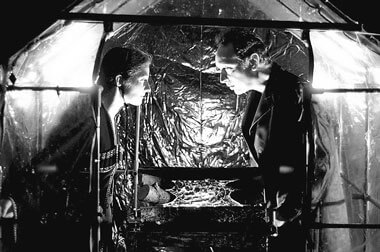Fragmented narrative pastiche evokes Nixon, a lost child and the Bible
Big Dance Theater implements the artistic promise of pastiche. Its works are richly layered and impressionistic––verbally and visually––and they are laced with original song, evocative dance sequences and a highly developed scene design concept.
The company, created in 1991 by choreographer Annie-B Parson and her husband, actor Paul Lazar, crafts together text from a wide range of disparate sources drawing new life from literary sources including Flaubert, Twain and Sophocles, as translated by Mac Wellman.
Fragments of disparate transcriptions merge in “Plan B” to form a surprisingly coherent narrative that examines the innocence and corruption of human nature. The work, which will have its New York premiere at Dance Theater Workshop beginning this Friday, imagines a character based on the diary of German wild child Kaspar Hauser, who is used as a patsy for a mastermind and his aide involved in some suspicious activity. The conspirators’ lines come from both the infamous “secret” Nixon tapes and the Bible. References to films of Japanese ceremonial dances shot in the 1920s by Jacob’s Pillow founders Ruth St. Denis and Ted Shawn also appear in the work.
In an interview, Lazar explained that the genesis of the piece was fragmentary.
“The Hauser text was found separately,” he said.
Parson was working on a solo for company member Tymberly Canale.
“She had never made a solo,” Lazar explained, “and to prepare, she began investigating solitude, or extreme versions of singleness. At first she looked at Emerson and Thoreau and different philosophies of self-sufficiency. Eventually, she found the Hauser tale.”
Kaspar Hauser was found at the gates of the city of Nuremberg at age 16 after having been abandoned in the woods for 12 years. His subsequent re-socialization proved tragic.
Independent of Parson’s research, Lazar and Molly Hickok, a company member, pursued their interest in the Nixon tapes, “the way they talked, the language they used.”
Lazar explained that the two texts became connected when they discovered a section of the tapes where Nixon and his advisors were trying to find the right person to do certain things on their behalf.
“What a perfect foil Kaspar might be,” said Lazar, “because he’s so malleable and so innocent.”
The biblical passages come from another project Lazar was working on.
“The reason it stuck was because it became part of the personality,” said Lazar, referring to his Bible-quoting character, “co-opting religiosity to rationalize intense and dangerous actions.”
The combination of these elements in the beloved leader’s persona is a chilling allusion to the current political climate in America.
In the final stages of developing “Plan B,” the company brought in playwright Len Jenkins.
“We had a lot of scenes, but couldn’t quite structure them,” said Lazar. “We gave him a sense of the narrative direction, and he wrote a draft version from the material we showed him. We took his narrative structure and about 20 percent of his words stayed. We stayed a lot with the original source material.”
Seamless and laden with dreamlike complexity, humanizing philosophy and affecting movement, “Plan B” extrapolates from two very different past lives a timely look into the hearts of men. The result is entrancing.
Original music by Gary Lucas, fanciful costumes by Claudia Stephens, set design by Joanne Howard and an assortment of moveable, interchangeable props (including a transparent house) by Seth Williamson enrich the work’s sense of the surreal.
Kate Johnson also performs, dancing and keeping the props moving in and out of different scenes.
Lighting design is by Jay Ryan and sound design is by Jane Shaw.



































